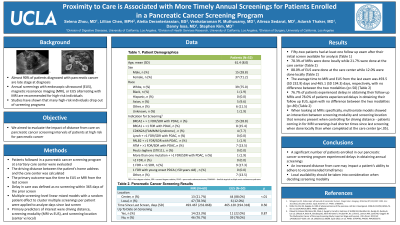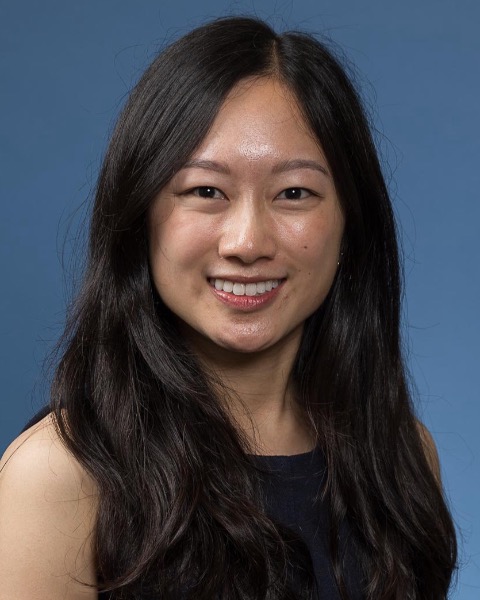Monday Poster Session
Category: Biliary/Pancreas
P1722 - Proximity to Care is Associated with More Timely Annual Screenings for Patients Enrolled in a Pancreatic Cancer Screening Program
Monday, October 28, 2024
10:30 AM - 4:00 PM ET
Location: Exhibit Hall E

Has Audio

Selena Zhou, MD
David Geffen School of Medicine at UCLA
Los Angeles, CA
Presenting Author(s)
Selena Zhou, MD1, Lillian Chen, MPH2, Aletta Deranteriassian, BS2, Venkataraman R. Muthusamy, MD3, Alireza Sedarat, MD1, Adarsh Thaker, MD1, Danny Issa, MD1, Stephen Kim, MD1
1David Geffen School of Medicine at UCLA, Los Angeles, CA; 2University of California Los Angeles, Los Angeles, CA; 3David Geffen School of Medicine at UCLA, Sherman Oaks, CA
Introduction: Almost 90% of patients diagnosed with pancreatic cancer are late stage at diagnosis. For this reason, annual screenings with EUS, MRI, or EUS alternating with MRI are recommended for high-risk individuals. However, studies have shown that many high-risk individuals drop out of screening programs with burden of travel as a postulated cause. We aimed to evaluate the impact of distance from care on pancreatic cancer screening intervals of patients at high risk for pancreatic cancer.
Methods: We evaluated patients followed in a pancreatic cancer screening program at a tertiary care center. The driving distance between the patient’s home address and the care center was calculated. The primary outcome was the time to EUS or MRI from the last screen. Delay in care was defined as no screening within 365 days of the prior screen. Multiple screening-level linear mixed models with a random patient effect to cluster multiple screenings per patient were applied to analyze days since last screen. Primary predictors of interest were driving distance, screening modality (MRI vs EUS), and screening location (center vs local).
Results: Fifty-two patients had at least one follow up exam after their initial screen available for analysis. 78.3% of MRIs were done locally while 21.7% were done at the care center (Table 1). Contrastingly, 88.0% of EUS were done at the care center while 12.0% were done locally. The average time to MRI and EUS from the last exam was 493.5 (SD 232.9) days and 465.1 (SD 194.3) days, respectively, with no difference between the two modalities (p=.50). Notably, 76.7% of patients experienced delays in obtaining their follow up MRIs and 78.0% of patients experienced delays in obtaining their follow up EUS, again with no difference between the two modalities (p=.89). However, when looking at MRIs specifically, multivariate models showed an interaction between screening modality and screening location that remains present when controlling for driving distance - patients coming in for MRI screenings had shorter times since last screening when done locally than when completed at the care center (p< .05).
Discussion: A significant number of patients enrolled in our pancreatic cancer screening program experienced delays in obtaining annual screenings. Shorter travel distance may improve a patient’s ability to adhere to recommended timeframes. Local availability should be taken into consideration when deciding screening modality.
Note: The table for this abstract can be viewed in the ePoster Gallery section of the ACG 2024 ePoster Site or in The American Journal of Gastroenterology's abstract supplement issue, both of which will be available starting October 27, 2024.
Disclosures:
Selena Zhou, MD1, Lillian Chen, MPH2, Aletta Deranteriassian, BS2, Venkataraman R. Muthusamy, MD3, Alireza Sedarat, MD1, Adarsh Thaker, MD1, Danny Issa, MD1, Stephen Kim, MD1. P1722 - Proximity to Care is Associated with More Timely Annual Screenings for Patients Enrolled in a Pancreatic Cancer Screening Program, ACG 2024 Annual Scientific Meeting Abstracts. Philadelphia, PA: American College of Gastroenterology.
1David Geffen School of Medicine at UCLA, Los Angeles, CA; 2University of California Los Angeles, Los Angeles, CA; 3David Geffen School of Medicine at UCLA, Sherman Oaks, CA
Introduction: Almost 90% of patients diagnosed with pancreatic cancer are late stage at diagnosis. For this reason, annual screenings with EUS, MRI, or EUS alternating with MRI are recommended for high-risk individuals. However, studies have shown that many high-risk individuals drop out of screening programs with burden of travel as a postulated cause. We aimed to evaluate the impact of distance from care on pancreatic cancer screening intervals of patients at high risk for pancreatic cancer.
Methods: We evaluated patients followed in a pancreatic cancer screening program at a tertiary care center. The driving distance between the patient’s home address and the care center was calculated. The primary outcome was the time to EUS or MRI from the last screen. Delay in care was defined as no screening within 365 days of the prior screen. Multiple screening-level linear mixed models with a random patient effect to cluster multiple screenings per patient were applied to analyze days since last screen. Primary predictors of interest were driving distance, screening modality (MRI vs EUS), and screening location (center vs local).
Results: Fifty-two patients had at least one follow up exam after their initial screen available for analysis. 78.3% of MRIs were done locally while 21.7% were done at the care center (Table 1). Contrastingly, 88.0% of EUS were done at the care center while 12.0% were done locally. The average time to MRI and EUS from the last exam was 493.5 (SD 232.9) days and 465.1 (SD 194.3) days, respectively, with no difference between the two modalities (p=.50). Notably, 76.7% of patients experienced delays in obtaining their follow up MRIs and 78.0% of patients experienced delays in obtaining their follow up EUS, again with no difference between the two modalities (p=.89). However, when looking at MRIs specifically, multivariate models showed an interaction between screening modality and screening location that remains present when controlling for driving distance - patients coming in for MRI screenings had shorter times since last screening when done locally than when completed at the care center (p< .05).
Discussion: A significant number of patients enrolled in our pancreatic cancer screening program experienced delays in obtaining annual screenings. Shorter travel distance may improve a patient’s ability to adhere to recommended timeframes. Local availability should be taken into consideration when deciding screening modality.
Note: The table for this abstract can be viewed in the ePoster Gallery section of the ACG 2024 ePoster Site or in The American Journal of Gastroenterology's abstract supplement issue, both of which will be available starting October 27, 2024.
Disclosures:
Selena Zhou indicated no relevant financial relationships.
Lillian Chen indicated no relevant financial relationships.
Aletta Deranteriassian indicated no relevant financial relationships.
Venkataraman Muthusamy: Boston Scientific – Consultant, Grant/Research Support. Capsovision – Stock Options, Stock-privately held company. Castle Biosciences – Consultant, Speakers Bureau. Endogastric Solutions – Advisory Committee/Board Member, Consultant, Speakers Bureau. Medtronic – Consultant. Pentax Medical – Consultant.
Alireza Sedarat indicated no relevant financial relationships.
Adarsh Thaker: Boston Scientific Corporation – Consultant, Speakers Bureau. Cook – Speakers Bureau. Fractyl Health – Grant/Research Support. Neptune Medical – Consultant. Steris – Consultant.
Danny Issa: Boston Scientific – Consultant, Speakers Bureau. Eli Lilly – Speakers Bureau.
Stephen Kim: Boston Scientific – Consultant.
Selena Zhou, MD1, Lillian Chen, MPH2, Aletta Deranteriassian, BS2, Venkataraman R. Muthusamy, MD3, Alireza Sedarat, MD1, Adarsh Thaker, MD1, Danny Issa, MD1, Stephen Kim, MD1. P1722 - Proximity to Care is Associated with More Timely Annual Screenings for Patients Enrolled in a Pancreatic Cancer Screening Program, ACG 2024 Annual Scientific Meeting Abstracts. Philadelphia, PA: American College of Gastroenterology.
